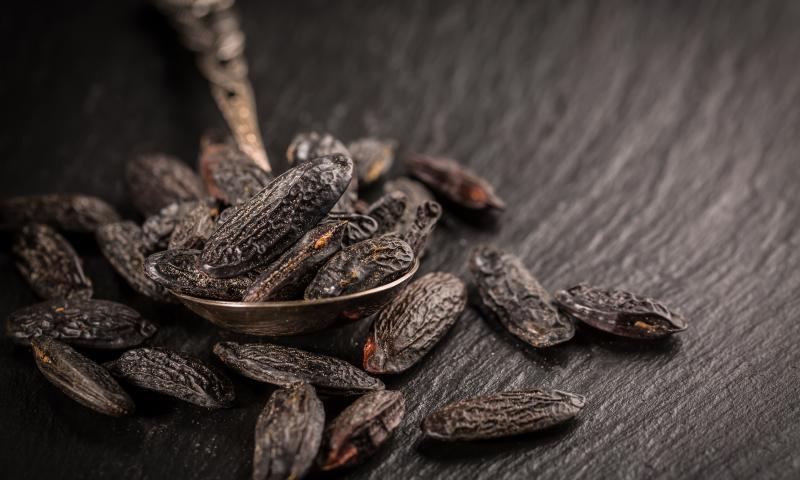 />
/>
Tonka, scientifically known as Dipteryx odorata, is a captivating tree native to the tropical rainforests of South America. This unique plant has been cherished for centuries for its aromatic beans, which are widely used in perfumery and cuisine. In this article, we will delve into the botanical characteristics, habitat, chemical composition, historical significance, taste, general health benefits, and indications for use of the Tonka bean.
Botanical Characteristics
Tonka trees are renowned for their impressive size, often reaching up to 100 feet in height. They feature tall trunks with dark brown bark and lush, vibrant foliage. The leaves are pinnately compound and glossy, with a deep green color. The tree produces small, fragrant, and delicate white flowers with a subtle hint of purple. These flowers eventually give way to the star of the show—the Tonka bean.
The Tonka Bean
Tonka beans are the true treasure of the Dipteryx odorata tree. These beans are usually around 1-2 inches long and resemble wrinkled, dark brown almonds. What makes Tonka beans truly remarkable is their rich and complex aroma, reminiscent of vanilla, almond, cinnamon, and cloves all rolled into one. This unique fragrance is the result of the bean's chemical composition, which we will explore shortly.
Habitat
Tonka trees are indigenous to the dense rainforests of South America, particularly in countries like Brazil, Venezuela, and Colombia. These trees thrive in the warm, humid, and tropical climates of these regions, often growing along riverbanks and in lowland areas. Due to their increasing popularity, Tonka trees are also cultivated in other parts of the world, but their natural habitat remains their primary home.
Chemical Composition
The remarkable fragrance of Tonka beans can be attributed to their rich chemical composition. These beans contain a compound called coumarin, which imparts a sweet, vanilla-like aroma. Other key constituents include dipteryxin, responsible for the almond and marzipan notes, and coumarinic acid, which contributes to the bean's characteristic scent. These compounds have made Tonka beans highly sought after in both perfumery and culinary circles.
Historical Significance
Tonka beans have a long and storied history, dating back to indigenous South American cultures. They were used in various rituals and ceremonies by these ancient societies, often as a form of incense. European explorers who encountered Tonka beans during their voyages in the 16th century brought them back to Europe, where they gained popularity among perfumers and chefs alike. Tonka beans have remained an essential ingredient in French perfumery, particularly in the creation of oriental fragrances.
Taste
The Tonka bean's fragrance isn't its only appealing feature; it also boasts a delightful flavor profile. When grated or crushed, Tonka beans release flavors reminiscent of vanilla, almond, and hints of spice. These beans are used as a spice or flavor enhancer in a variety of dishes, including desserts, sauces, and beverages. However, it's important to note that Tonka beans should be used sparingly due to their potent flavor.
General Health Benefits
Tonka beans, when used in moderation, offer a range of potential health benefits, excluding specific medical claims. These benefits include:
Aromatic Relaxation: The soothing aroma of Tonka beans can help reduce stress and anxiety, promoting relaxation and overall well-being.
Digestive Aid: Tonka beans have been traditionally used as a digestive aid due to their aromatic compounds, which can stimulate appetite and ease digestive discomfort.
Flavorful Nutrient Boost: Adding Tonka bean to your dishes can enhance their flavor without the need for excessive sugar or salt, promoting healthier eating habits.
Indications for Use
Incorporate Tonka beans into your culinary adventures, taking care to use them sparingly due to their potent aroma and flavor. Grate or crush a small amount of the bean to infuse your dishes with their unique taste and fragrance. Tonka beans can be used in desserts, coffee, cocktails, and even savory dishes like sauces and stews.
Conclusion
Tonka (Dipteryx odorata) is a remarkable plant with a rich history, unique aroma, and delightful flavor. Its beans, prized for their fragrance and versatility, have left a lasting impression on both perfumery and culinary arts. While it offers a range of potential health benefits when used judiciously, Tonka's true charm lies in its ability to transport us to the lush rainforests of South America with its enchanting scent and exquisite flavor.
